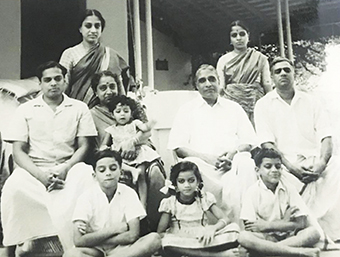The mercantile community of Vysial Street celebrate a number of festivals at their Vasavi Kannikaparameswari Temple. The Navarathri is used to be the time when eleven types of flavoured rice would be served to the people of the locality. Puliyodharai, Thakkali pandu annam, Pongal, chakkara Pongal, thenkai annam, nimma pandu annam, podi annam, kadambam annam, perugu annam etc., used to be cooked and served to thousands of people. The flavoured rice used to be packed in plantain leaves with old newspapers as the external wrapper and distributed from the entrance of the temple.
The birthday of Vasavi Kannika Parameswari used to be another opportunity to serve a full meal on plantain leaves to thousands of people. The Coimbatore Arya Vysya Mahasabhai Trust takes care of this event with utmost care. The meal would consist of sweets like laddoo, pappu, nei, charu, pulusu, appadam, vadigalu, koora among other items like paravannam. It will be a samabandhi bhojanam. The jewellers used to shut shop for the day and attend the festivities. The Coimbatore Jewellers Association used to declare Vasavi Jayanthi as a holiday and would also notify the labour department on a yearly basis.
Chillara Appam was another famous item made by them and the preparation used to take about three days. This hard to make item is a delicacy. Pesala gedigalu, Nippattu (originally from Bengaluru), pithugu pappu pulusu and kottu pindi rottah, Alagiri Dosa (Alagar Gudi Dosa) are also a few of the items. This Alagiri Dosa is eaten along with Miriam in some of the households. This is made out of red chillies, garlic, gingelly oil and lime with a bit of tempering. Many people consider this to be a delicacy and it is very spicy. Pesala pappu dosa and thurmina theevu thenkai was a favourite for kids. Bombay Chutney was eaten with idli and dosa for tiffin.
Muddha kudumu was one type of idli and it was eaten with pappula paravannam. This idli had a bit of shredded coconut in it. Amirtha Pindi was made for ekadasi regularly. It was either made into patties or cubes. It would make a good travel snack and would stay fresh for a full day. Pulusu pindi was one kind of a rice uppuma and one used tamarind and hours of cooking by hand. The cooks used to purposely get it stuck underneath and this would be scraped out for eating. These bits came to be known as maadu it was loved by the kids. There used to be quarrel for this adugu antina maadu in the houses. Sometimes pulusu pindi was made for this purpose itself.
Thaliga appadam was another lovely item. Thin appadams were poured into the pans and steamed. The steamed batter used to be fantastic. It was laced with a bit of spice and a fight would erupt for having it. The dried ones were stored for making appadams and it was had with lunch or dinner for it will be a good accompaniment for rice and charu or pulusu. The vadigalu which were made during the months of summer was a time for frolic. Women used to make the vadigalu dough and keep them in their backyards on old panchalu (dhotis) or solugulu. The sun dried vadigalu were stored and fried for consumption. However the vadigalu pindi or the semi sundried vadigalu which was known as the endi endani vadigalu was much preferred. Men, women and children used to scoop out the semi dried vadigalus and gorge on them. One of the dhotis or a part of the vadigalu was meant for this purpose.
Pappu Rottah is an all time favourite. Thin genji dosas will be made in the afternoons itself. The dosa batter used to sprayed on the pan and the cooked dosas used to be let to cool. Subsequently it will be diced and processed with turmeric. The pappu rottah used to be eaten with charu and perugu (curd). The pappu rottah dosas were eaten with ulligedda or ullipaya pickle by the people of the household. Since the pappu rottah dosa was a much loved item, the homemakers used to make more of them and offer it as a snack. The school going kids used to have pappu rottah dosa as the evening tiffin.
It is interesting to check out on the origin of these items. Some of them are variants of old Andhra food and some of them are fusion food from the past. However there are quite a few regular items which are unique to these people. Food historians may agree that many of these items were made by the members of the Telugu mercantile community exclusively for themselves after migrating from the Telugu speaking parts of the country to the Tamil speaking parts more than five centuries ago. The migrations must have begun in the fourteenth century itself and gone on for a long time. Many of them settled down for good in the Tamil regions and even adopted the local deities as their Kula deivams over time.
The food of the members of the Telugu mercantile community is worth a deep study for it will help us to understand our gastronomic history and cultural background better. People who eat this food will agree that the stomach is the way to the heart.
—Rajesh Govindarajulu
Vysial Street Telugu Speaking People’s Food Culture (Part II)




